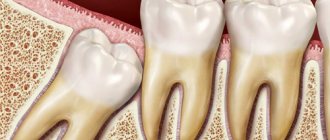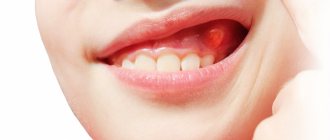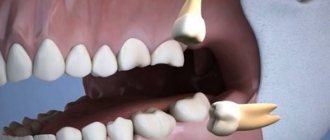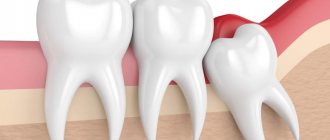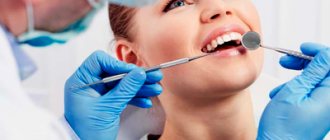A wisdom tooth is the third molar, which appears later than the others, and sometimes does not erupt at all. A person cannot have more than 4 wisdom teeth. The approximate time when teething begins is 18 - 27 years.
Modern experts classify wisdom teeth as rudiments - elements that, in the course of evolution, have lost their role for humans. The specific location of third molars causes a number of difficulties in terms of caring for them.
“Eights” are not loaded like other teeth. In addition, they almost always tend to erupt painfully. It is not surprising that they are called the most problematic, and most dentists recommend removing wisdom teeth at the first opportunity.
Why can wisdom teeth hurt?
Currently, dentists consider the third molar to be a vestigial organ, which in the process of evolution has lost its functional load and relevance. For ancient man, it served to chew hard food, which is practically absent in the modern diet, which means there is no longer any need to use the wisdom tooth when chewing. This fact is supported by the presence of approximately 10% of the planet's population, whose representatives do not have eights at all, which is not a pathology. The remaining 90% of the population faces unpleasant wisdom tooth problems. The third molar can hurt and bother you for various reasons.
When teething
By the age of 18–25, a person’s jaw is already formed. And, naturally, when a wisdom tooth is cut, it may simply not have enough space in the dentition. The eight begins to put pressure on the seven in front, which in turn puts pressure on the sixth molar, etc. As a result, the entire jaw hurts and “aches.”
Often the third molar does not find a place for itself in the dentition and begins to grow dystopically - it deviates to the side, turns around its axis, moves forward or backward. In this case, the gums near the wisdom tooth hurt and inflammation may occur. Not to mention the fact that in adulthood the gums have a fairly dense structure, the resistance of which must be overcome by the figure eight. And in order to erupt safely, it literally tears the soft tissue. Naturally, this process is accompanied by pain and discomfort.
For dental disease
An already formed wisdom tooth will hurt if it is susceptible to any disease. The most common are caries, pulpitis and periodontitis.
- Caries is a pathological process that leads to the destruction of hard tooth tissues, which is initially accompanied by increased sensitivity of the enamel, and subsequently severe pain in the wisdom tooth.
- Pulpitis - inflammation of the internal tissue of the figure eight (pulp) is a consequence of untreated caries. In rare cases, infection enters the pulp through the apical foramen, which may be due to improper position of the molar. With pulpitis, the wisdom tooth hurts very much, since the pulp is penetrated by a large number of nerve endings.
- Periodontitis - inflammation of the periodontium (connective tissue surrounding the tooth) can be caused by injury to the gums or infection during the eruption of the figure eight. In this case, localized, constant pain is observed, which gradually increases and becomes pulsating, which indicates a purulent course of the process.
Important! If an already erupted wisdom tooth suddenly begins to hurt, then you need to show it to the dentist as soon as possible. Timely diagnosis will avoid infection of the pulp, periodontium and the development of complications.
For pericoronitis
Pericoronitis - inflammation of the soft tissue of the gums surrounding the erupting figure eight, is the most common. The problem is that when a wisdom tooth comes in, it first cuts through the mucous membrane with its tubercles, forming a so-called “hood” above itself - part of the gum. Thus, partly the third molar is already visible, and partly is still covered by the “hood” of the gums. Hanging over the figure eight, it creates favorable conditions for the accumulation of food particles, plaque, and microbes, which, sooner or later, leads to inflammation. The development of pericoronitis will also be accompanied by pain.
Important! If the gum above the wisdom tooth forms a “hood” and is inflamed, then it must be excised (removed). The procedure is carried out in the sterile conditions of a dental clinic.
How long will the cutting and toothache last?
The process of cutting through the figure eight is long and highly individual. In some patients it “appears” in 3–4 months, in others it may take 1–2 years, and in others it remains incompletely erupted. Quite often, a wave-like “appearance” of the third molar is observed - either it is intensively cut, or it freezes.
As for severe pain, as a rule, it is present only at the beginning of the process - at the stage when the figure eight cuts through the dense gum tissue. And again, this moment can happen quite quickly or drag on for a long time.
When the first signs of figure eight eruption appear, it is better not to postpone a visit to the doctor. Even if the process does not cause severe pain or discomfort, it is better to show it to the dentist. An experienced specialist will examine the condition of the third molar and provide assistance that will facilitate the process of “the birth of the tooth.”
Preventive measures
It is impossible to completely protect yourself from infections. But it is possible to create conditions under which the tonsils will provide maximum resistance to bacterial invasion. To do this you need:
- Wash your hands regularly.
- Keep your mouth clean and healthy.
- Support the immune system (taking vitamins, proper nutrition, sports and hardening).
- Do not drink too cold or hot drinks, especially before going outside in cold weather.
- From time to time, do a preventive massage - just throw back your head and do a few strokes from the jaw to the chest. This method is especially effective before going outside in the cold.
- Avoid hypothermia, especially in the neck, head and legs.
“It’s better to have at least some tonsils than not to have them at all,” experts say.
The palatine tonsils (tonsils) are an organ that is a collection of lymphoid tissue. They are located on the border between the oral cavity and the pharynx, in the niches that are formed by the palatine arches. This location makes the tonsils an outpost of immune defense: they are the first to encounter viruses and bacteria that enter our body with the flow of air or food. Removing the tonsils deprives the body of protection.
How to understand that a wisdom tooth is cutting?
It's not difficult to understand. Normally, this process is accompanied by discomfort, engorgement and slight swelling of the gums in the place where the tooth is cut. At the moment of eruption, increased salivation, a feeling of fullness and tolerable pain will be observed. They can intensify during eating and hygiene procedures. Visually and by touching the tongue, you can see and feel the protruding tubercles of the figure eight.
In the pathological course of the process, the following symptoms may join the above-described symptoms.
- Redness and swelling of the gums indicate inflammation of the “hood”.
- It hurts to open your mouth - the inflammation process is progressing and has spread to the masticatory muscle.
- It hurts to swallow - a symptom indicates the presence of purulent inflammation of the soft tissues closer to the tongue.
- High temperature - the inflammatory process progresses.
- The third molar, the adjacent tooth and gums are very painful - most likely, the figure eight is growing in the wrong direction.
Additionally, symptoms may occur depending on the location of the wisdom tooth.
- The upper eights can erupt towards the cheek and injure its mucous membrane, causing pain.
- The lower molars often form a “hood” and grow with an inclination towards the seven, forming a gap. It is difficult to clean with a brush. Over time, a stable plaque and tartar form in it, which leads to the development of caries.
You should not trust various kinds of myths, they say, the appearance of a wisdom tooth is always excruciatingly painful, very problematic and you just need to endure it. It is not true! Normally, the process does not cause excruciating pain and passes with tolerable discomfort. On the contrary, problem eights hurt a lot, provoking the development of inflammation and complications. Therefore, it is better not to delay visiting the dentist.
Does it make sense to treat wisdom teeth?
An experienced and self-respecting dentist will always fight for every tooth to the last. And wisdom teeth in this case are no exception. After all, no one knows how the patient’s life will turn out in the future. Perhaps in the future he will need prosthetics, and the figure eight will be used as a supporting tooth for installing a prosthesis. Therefore, if the appearance of a third molar does not pose a threat to neighboring teeth and oral health, the dentist will take actions aimed at facilitating the process and preserving the tooth. Well, unless, of course, the patient insists on its removal.
If the current situation is serious, then removal of the wisdom tooth is inevitable. Including in those cases when the figure eight does not hurt much (or does not hurt at all), but is covered with caries and is gradually destroyed. It is more rational and safer to remove such a tooth and forget about the problems.
Preventing gum disease
Prevention can prevent many serious oral problems. Main recommended activities:
- Brush your teeth regularly. If you don't have a brush, you can use dental floss or rinse your mouth with salted water.
- Carry out regular preventive examinations with your dentist. You should also immediately treat sore teeth and seek medical help if you suspect other serious problems.
- Try not to injure your gums with hard foods and sharp objects. It is better not to eat hard candies, crackers, unpeeled seeds, and it is strictly forbidden to use your teeth to open traffic jams, bite small wires, hold nails and other similar actions.
- Massage the gums. This can be done with a soft brush or chewing gum. You can also chew comb honey.
- Maintain a nutritious diet with calcium-containing foods. This element is found in high concentrations in dairy products, beans, meat and eggs.
- Stop smoking.
It's easy to follow these recommendations. Their benefits extend not only to the oral cavity, but to the entire body. If the gums are swollen or the cheek is swollen, then poisoning of the body often occurs due to intoxication. Therefore, it is better to take measures to prevent this problem.
There are many reasons for gum swelling, and the treatment method depends on the factors that led to this phenomenon. If the case is not entirely obvious, then only a doctor can make a correct diagnosis, perform the necessary procedures and prescribe medications. It is necessary to seek professional help in a timely manner to avoid the development of complications.
When do you need to see a dentist urgently?
Contacting a dentist is required in the following cases.
- Pericoronitis
– the “hood” will be excised. - The figure eight puts pressure on neighboring teeth
- it needs to be removed. - Initial caries
– treatment will be carried out. - Medium, deep caries or rotten tooth
- a clear removal of the figure eight. - The wisdom tooth is loose
- a diagnosis of its condition will be carried out, according to the results of which the molar will be treated or removed. - Pulpitis
– if the root canals are passable, they will be filled.
This list should also include the above symptoms of pathological teething - pain when opening the mouth, swallowing, high temperature. If they appear, you should contact your dentist immediately, since this is a serious inflammatory process, the localization of which requires adequate treatment.
The reason for contacting a specialist may also be the “normal behavior” of the number eight. In this case, the doctor will simply make a small incision on the gum, thereby facilitating the eruption of the wisdom tooth. After a simple procedure, the process will be less painful, and the incision site will heal quickly, after pain for 2 to 4 days.
When should a tooth be removed?
Direct indications for wisdom tooth removal are the following pathologies and conditions.
- There is no place in the dentition for a number eight.
- Dystopic tooth (molar occupies an anatomically incorrect position).
- The appearance of wisdom teeth threatens the molars in front.
- Severe forms of caries that destroy the tooth.
- The third degree of mobility of the figure eight.
- Upcoming installation of braces.
If removal is not carried out, the development of complications is inevitable. The number eight will destroy adjacent teeth and provoke the development of pulpitis, periodontitis, and extensive caries. Eventually it will fall out on its own, but at too great a cost to the patient.
There is no need to be afraid of wisdom tooth removal. Depending on the complexity of the problem, third molar extraction will last from 20 minutes to 2 hours. The operation is performed using local anesthesia or sedation, which ensures that the procedure is painless.
How to relieve pain?
When visiting the clinic, the attending physician gives valuable recommendations that will help relieve the process of the “appearance” of the figure eight. If you decide to act on your own, you can use the following medicines and folk remedies.
Pills and medicines
- Tablets: “Nimesil”, “Analgin”, “Solpadein”, “Tempalgin”, “Ketanov”, “Paracetamol”, “Ibuprofen” are used according to the instructions.
- Gels and ointments: “Cholisal”, “Kamistad”, “Kalgel”, “Metrogil Denta” are applied to the site of tooth eruption.
- Solutions: “Chlorhexidine”, “Miramistin” and “Furacilin” are used for antiseptic treatment of the oral cavity.
Folk remedies
- Soda, saline or soda-salt solution - 1 teaspoon of product for 1 glass of warm water, stir until completely dissolved, rinse the problem area every 2 - 3 hours.
- Sage, calendula, plantain, St. John's wort - to prepare a decoction, pour 1 tablespoon of the product into 1 glass of boiling water, leave for 20 - 30 minutes, use for rinsing every 2 - 3 hours.
Home methods of pain relief will be effective if there are no serious problems with the eruption of the figure eight. If inflammation occurs, the tooth is rotten or very loose, then they will not help, but will only aggravate the problem, which will lead to the development of complications.
Wisdom teeth removal with 20% discount
Moscow
ethnoscience
What to do if the tonsils are swollen, from the point of view of alternative medicine? The development of pathology requires an integrated approach to treatment aimed at relieving general swelling of the tonsils and eliminating the inflammatory process.
The following procedures can help with this:
- Rinse. Treatment of swollen tonsils using traditional medicine can begin with traditional rinsing of the throat, and this should be done as often as possible. Medicinal plants such as calendula, chamomile, and propolis are ideal for preparing rinses. If rinsing is performed by an adult, then a small amount of vodka or alcohol can be added to the prepared broth - no more than 1 tbsp. l. This will enhance the effect of the procedure. Children and pregnant women should not add alcohol.
- Inhalations. If you have a sore throat and swollen tonsils, inhaling the vapors of herbal infusions will help destroy pathogenic flora, relieve inflammation and normalize the general condition of the respiratory system. You can purchase ready-made inhalation products at the pharmacy. Essential extracts of coniferous trees and medicinal plants - chamomile, calendula and St. John's wort are effective.
- Warming up. Using this method at home requires caution. Often, warming the throat can cause the inflammatory process to spread to nearby organs from the source of infection, especially if it is performed incorrectly. It is best to practice the warm-up procedure in a physical therapy office, but if this is not possible, your healthcare provider may allow you to do the procedure at home using warmed sea salt or a heating pad.
- Drink plenty of fluids. The symptoms of swollen tonsils can be relieved by drinking plenty of fluids. Drinking plenty of fluids washes away some of the pathogenic flora from the surface of the tonsils and gradually removes the infection from the body naturally, relieving the symptoms of intoxication. You need to drink especially a lot if you are undergoing antibiotic therapy. A decoction of rose hips, warm milk, and tea with honey are recommended as a drink.
Where can the pain go?
Quite often, the process of growth of eights is accompanied by uncharacteristic symptoms. Moreover, some of them are due to the growth of the molar itself, and the other part indicates the development of complications. Let's take a closer look - can a wisdom tooth give into...?
- Head
- in case of complicated teething it can. - Eye
– with complicated eruption of the upper molars and the development of an abscess, it can. - Tongue
- a symptom indicates the presence of purulent inflammation of the soft tissues closer to the tongue. - Ear
– indicates the development of inflammation, pulpitis or dental cyst. - Throat
- most likely we are talking about pulpitis. - Jaw
- a symptom characteristic of complicated teething and inflammation. - The neck
is unlikely, unless we are talking about the spread of infection and inflammation of the lymph nodes. - Temple
– Clicking and pain in the temple may be present due to tension in the temporomandibular joint, which occurs from constant pain. - The teeth are nearby
- of course, because the figure eight can put pressure on them.
Important! The above list is a serious signal to contact a dentist. Don't delay your visit to the clinic!
Inflammation of the tonsils: causes
Children often suffer from tonsillitis, since their immune system is not as strong as that of adults.
Therefore, microbes, entering the lymphoid tissue of the tonsils, begin to actively multiply there, secrete the products of their vital activity, thereby causing an inflammatory process with intoxication. With strong immunity, the tonsils are actively involved in their work and suppress the proliferation of bacteria, but if the body’s protective functions are insufficient, inflammation occurs that requires treatment. There is debate among experts about the need for tonsils, because on the one hand they are a protective barrier, and on the other hand they are a carrier of infection. In this case, it is important to note that healthy tonsils protect the upper and lower respiratory tract from microbes entering them. Thereby preventing the development of bronchitis and pneumonia.
If the tonsils harbor a chronic infection, which, with the slightest accompanying factors, makes itself felt in the form of inflammation and even abscesses, and conservative treatment methods do not produce results, they must be removed. The decision on surgical intervention is made by the doctor, after appropriate tests and observations of the patient.
Regarding the reasons why the tonsils may become inflamed, these include:
- bacterial infection, in 80% of cases it is streptococcus, but it can also be staphylococcus and pneumococcus;
- a viral infection can also cause inflammation, but less frequently;
- fungal infection.
Factors for infection are:
- caries, which is also a chronic source of infection in the mouth;
- dirty hands, unwashed vegetables or fruits;
- close contact with a previously ill person;
- weakened immunity as a result of hypothermia or other diseases.
